October to December, 2019
Introduction
About the Ontario Employment Report
The Ontario Employment Report is released four times a year and provides an assessment of the current trends and developments in the Ontario labour market. The Ontario Employment Report is a companion report to the Ontario Economic Accounts, which provides an overall assessment of the current state of the Ontario economy. All estimates in this report are based on Statistics Canada’s Labour Force Survey.
Methodological note
In the current issue, year-over-year change represents change between the averages in the fourth quarter of 2018 and the fourth quarter of 2019. Note that the Ontario Economic Accounts report primarily shows changes between the previous and the current quarter.
This report uses seasonally adjusted data in charts displaying data with a monthly frequency in the Overview section.
Unadjusted data is used in charts and tables showing the changes for the current quarter compared with the same quarter for the previous year. Unadjusted data is also used to calculate annual averages, year-to-date averages and 2019 fourth quarter averages.
Overview
Ontario’s labour market overview
Employment:
+232,500 net new jobs year-over-year
+180,800 full-time jobs year-over-year
Unemployment rate:
4.8% in the fourth quarter of 2019
Year-over-year, Ontario’s employment grew by 3.2% (232,500), higher than the Canadian rate of 1.9%.
Ontario’s unemployment rate was 4.8% in the fourth quarter of 2019, lower than the Canadian rate of 5.2%.
Year-over-year overview
Ontario’s labour market, 2008-2019

The combination line and area chart shows Ontario’s unemployment rate (line chart) and employment (area chart) from January 2008 to December 2019. Ontario’s unemployment rate has trended downwards since the recession, reaching 5.3% in December 2019. Employment in Ontario has risen steadily since the recession, reaching just over 7.5 million workers in December 2019, putting it well over the pre-recession level of roughly 6.6 million.
Between the fourth quarter of 2018 and 2019:
- full-time employment increased by 3.1% and part-time employment increased by 3.7%
- gains occurred in the private sector (+2.3%), public sector (+3.6%), and self-employment (+6.3%)
- there were significant employment gains in the services-producing sector (+3.8%), and a modest increase in the goods-producing sector (+0.8%)
- four of the five Ontario regions posted employment gains with Eastern Ontario experiencing the strongest employment growth (+7.0%)
- older workers and youth experienced above-average employment growth (+5.7% and +5.1%, respectively)
- the average hourly wage increased by 4.5%, to $28.73
Type of Work quarterly details
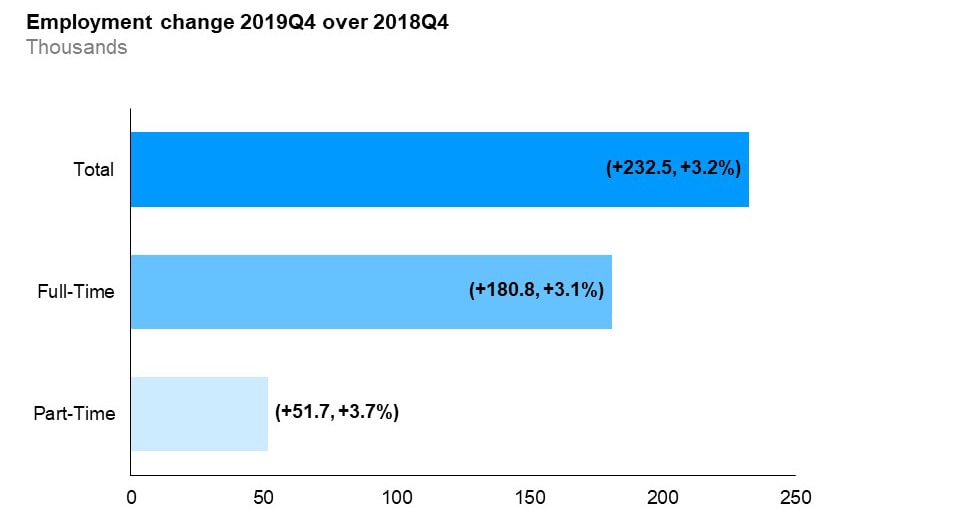
The horizontal bar chart shows a year-over-year (between the fourth quarters of 2018 and 2019) change in Ontario’s employment by full-time and part-time status. Total employment increased by 3.2%, driven by gains in both full-time employment (+3.1%) and part-time employment (+3.7%).
Year-over-year, full-time employment increased by 3.1% and part-time employment increased by 3.7% in the fourth quarter.
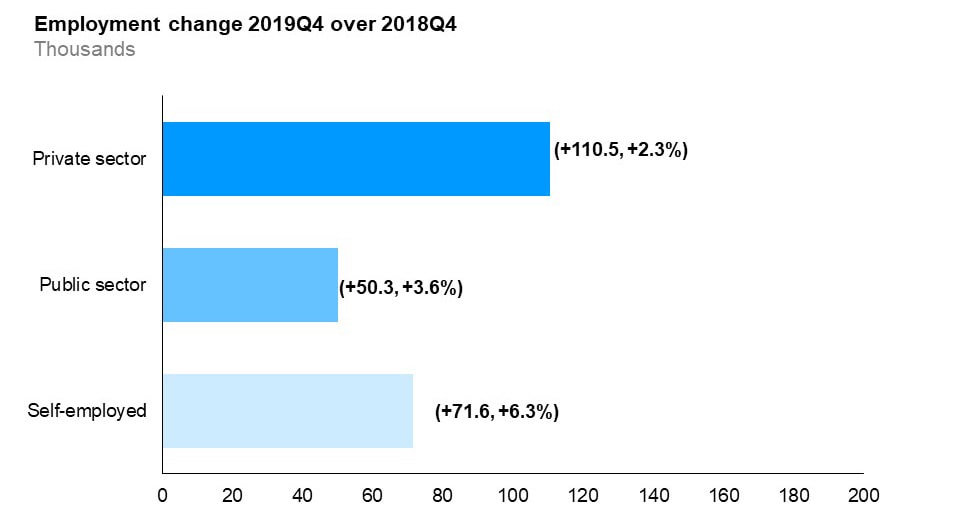
The horizontal bar chart shows a year-over-year (between the fourth quarters of 2018 and 2019) change in Ontario’s employment for the private sector, public sector and self-employment. Employment increased in all sectors. Private sector employment increased by 2.3%, while self-employment grew by 6.3% and public sector employment decreased by 3.6%.
Year-over-year, employment grew in all sectors (the private sector, the public sector and self-employment). The strongest growth was in self-employment (+6.3%).

The horizontal bar chart shows a year-over-year (between the fourth quarters of 2018 and 2019) change in Ontario’s employment for above- and below-average wage industries, compared to the paid employment in all industries. Employment in above-average wage industries (+5.9%) increased while employment in below-average wage industries decreased (-0.5%). Paid employment in all industries (excluding self-employment) rose by 2.6%. Above-average wage industries are defined as those with wage rates above the average hourly wages of all industries in 2019.
Year-over-year, paid employment increased in above-average wage industries by 5.9%, while employment in below-average wage industries decreased by 0.5%.
Sector and occupation quarterly details
Employment change by industry, goods-producing industries
Year-over-year, there were significant employment gains in the services-producing sector (+3.8%) and modest employment gains in the goods-producing sector (+0.8%).
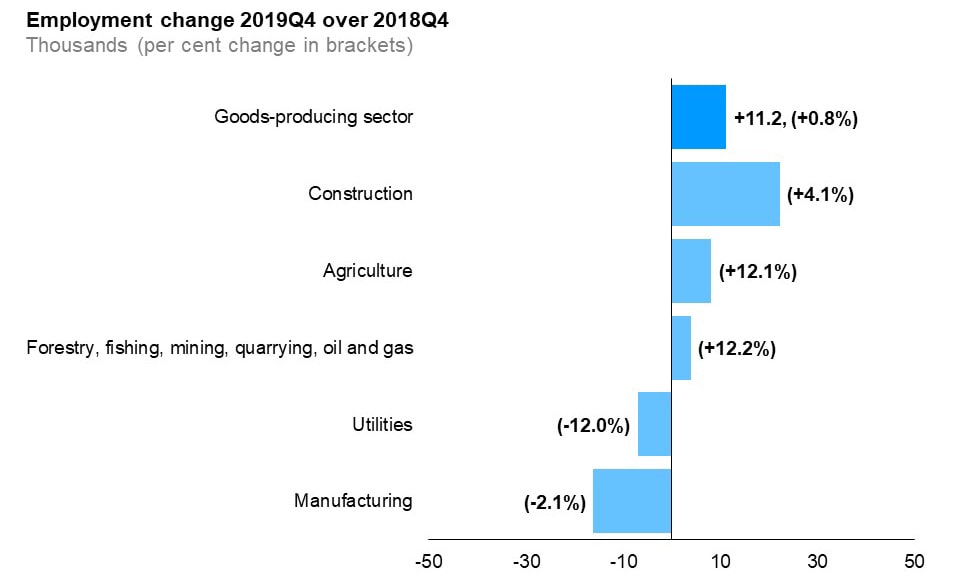
The horizontal bar chart shows a year-over-year (between the fourth quarters of 2018 and 2019) change in Ontario’s employment by industry for goods-producing industries. Construction experienced the largest employment gains (+4.1%), followed by agriculture (+12.1) and forestry, fishing, mining, quarrying, oil and gas (+12.2%). Manufacturing had the largest employment decline (-2.1%), followed by utilities (-12.0%). The overall employment in goods-producing industries increased by 0.8%.
Among goods-producing industries, the employment increase was driven mostly by construction (+4.1%). Forestry, fishing, mining, quarrying, oil and gas industries and agriculture industries experienced the largest growth rates among goods-producing industries (+12.2% and +12.1% respectively), while employment in utilities and manufacturing declined (-2.1%).
Employment change by industry, services-producing industries
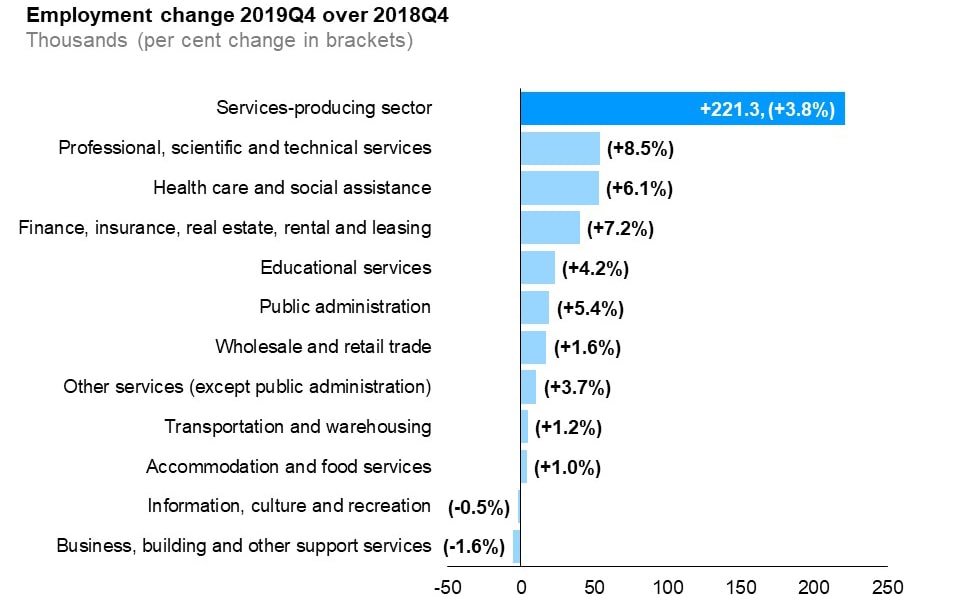
The horizontal bar chart shows a year-over-year (between the fourth quarters of 2018 and 2019) change in Ontario’s employment by industry for services-producing industries. Nine services-producing industries had an increase in employment. Professional, scientific and technical services experienced the biggest employment gain (+8.5%), followed by health care and social assistance (+6.1%) and finance, insurance, real estate, rental and leasing (+7.2%). Tow industries experienced employment declines. The biggest employment decline occurred in business, building and other support services (-1.6%), followed by information, culture and recreation (-0.5%). The overall employment in services-producing industries increased by 3.8%.
Among services-producing industries, professional, scentific and technical services gained the most jobs and also experienced the highest rate of employment growth (+8.5%). Additionally, health care and social assistance (+6.1%) and finance, insurance, real estate, rental and leasing (+7.2%) were the second and third industries that gained the most jobs. Employment in business, building and other support services and information, culture and recreation slightly decreased (-1.6% and -0.5% respectively).
Employment change by occupational group

The horizontal bar chart shows a year-over-year (between the fourth quarters of 2018 and 2019) change in Ontario’s employment by broad occupational group. Eight occupational groups experienced employment gains. Education, law, social, community and government services occupations had the biggest employment gain (+7.6%), followed by sales and services (+2.9%), and occupations in trades, transport and equipment operators (+3.8%). Employment in tow occupational categories decreased. Health occupations experienced the biggest decline (-1.7%), followed by natural resources, agriculture and related occupations (-8.3%).
Among broad occupational groups, education, law, social, community and government services occupations saw the largest increase in employment (+7.6%), while employment in natural resources, agriculture and related occupations and health occupations decreased the most (-8.3%).
Geographic region
Ontario regions

The map shows Ontario’s five regions: Northern Ontario, Eastern Ontario, Southwestern Ontario, Central Ontario and the Greater Toronto Area. This map is based on groupings of Statistics Canada’s economic regions.
Employment change by Ontario region

The horizontal bar chart shows a year-over-year (between the fourth quarters of 2018 and 2019) change in employment in the five Ontario regions: Northern Ontario, Eastern Ontario, Southwestern Ontario, Central Ontario and the Greater Toronto Area (GTA). Employment increased in four of the five regions. The rate of employment growth was highest in Eastern Ontario (+7.0%), followed by the GTA (+3.9%), Southwestern Ontario (+2.1%) and Central Ontario (+1.1%). Employment declined in Northern Ontario (-1.6%). The overall employment increased by 3.2% (+232,500).
Year-over-year, employment increased in four of the five Ontario regions. The rate of employment growth was highest in Eastern Ontario (+7.0%), followed by the Greater Toronto Area (GTA)
Unemployment rates by Ontario region
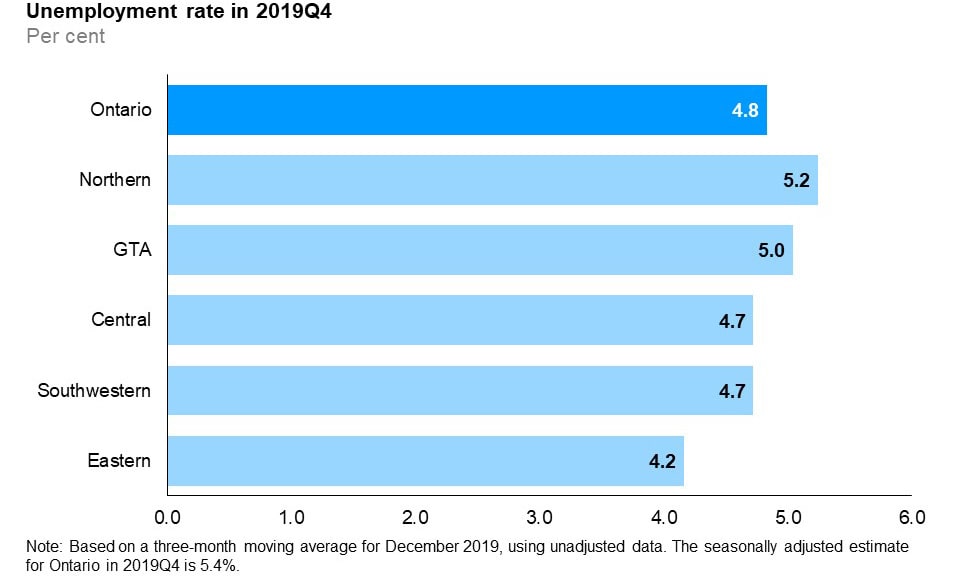
The horizontal bar chart shows unemployment rates by Ontario region in the fourth quarter of 2019. Northern Ontario had the highest unemployment rate at 5.2%, followed by the Greater Toronto Area (5.0%), Central Ontario (4.7%), Southwestern Ontario (4.7%) and Eastern Ontario (4.2%). The overall unemployment rate for Ontario was 4.8%.
In the fourth quarter of 2019, Eastern Ontario had the lowest unemployment rate (4.2%), while Northern Ontario had the highest unemployment rate (5.2%).
Participation rates by Ontario region
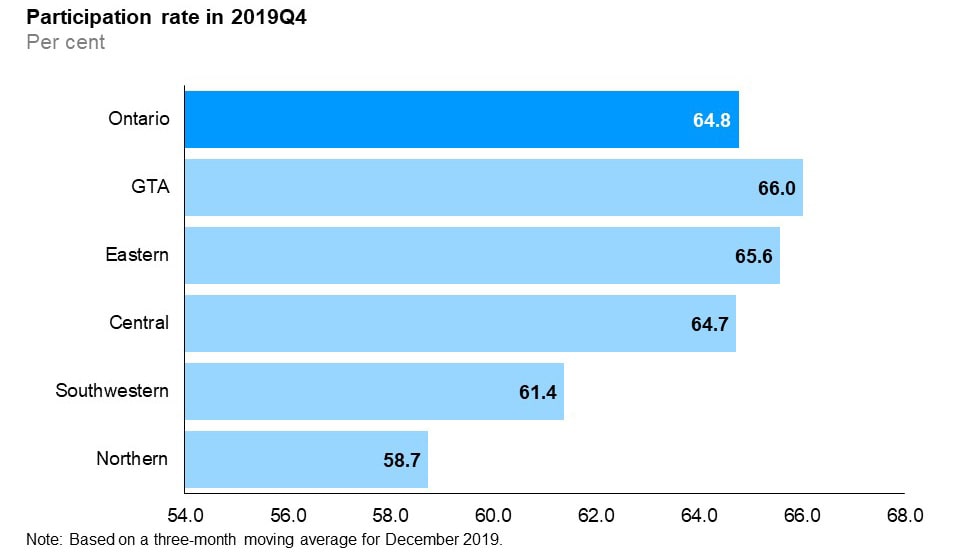
The horizontal bar chart shows participation rates by Ontario region in the fourth quarter of 2019. The Greater Toronto Area had the highest participation rate at 66.0%, followed by Eastern Ontario (65.6%), Central Ontario (64.7%), Southwestern Ontario (61.4%) and Northern Ontario (58.7%). The overall participation rate for Ontario was 64.8%.
Quarterly labour force participation rates varied considerably among the economic regions. In the fourth quarter, participation rates ranged from 58.7% in Northern Ontario to 66.0% in the GTA.
Age and gender quarterly details
Employment change by age group and gender
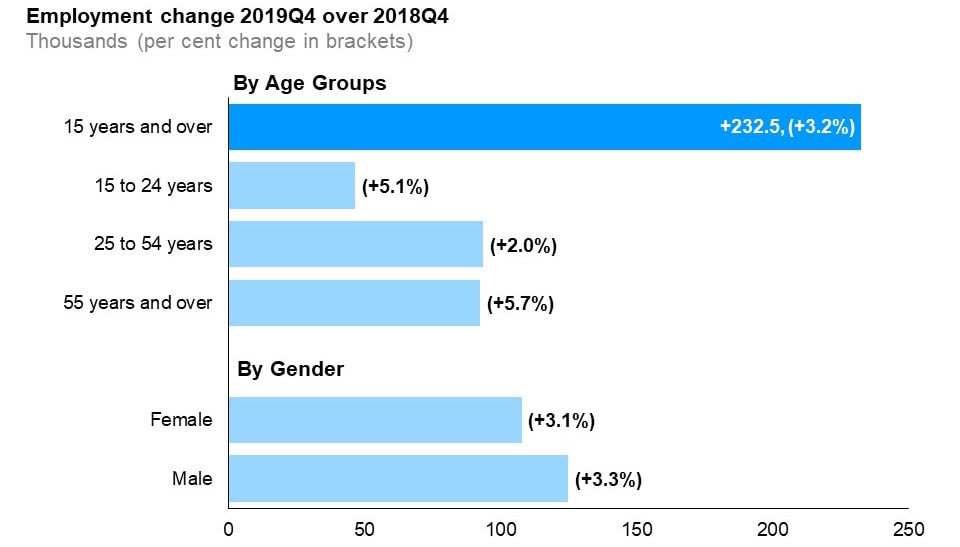
The horizontal bar chart shows a year-over-year (between the fourth quarters of 2018 and 2019) change in Ontario’s employment for the three major age groups, as well as by gender, compared to the overall population. Ontarians aged 25 to 54 years gained the most jobs (+2.0%), followed by Ontarians aged 55 years and over (+5.7%). Employment for Ontarians aged 15 to 24 years increased by +5.1%. Total employment (for population aged 15 and over) increased by 3.2%. Males (+3.3%) gained more jobs than females (+3.1%).
Compared to the same quarter last year, older workers (55 years and over) and youth (15 to 24 years) experienced above-average employment growth (+5.7% and +5.1% respectively). Core-aged workers (25 to 54 years) and older workers gained the most jobs.
Unemployment rates by age group and gender

The horizontal bar chart shows unemployment rates for the three major age groups, as well as by gender, compared to the overall rate, in the fourth quarter of 2019. Youth (15 to 24 years) had the highest unemployment rate at 10.5%, followed by the core-aged population (25 to 54 years) at 4.1% and older Ontarians (55 years and over) at 3.4%. The overall unemployment rate in the fourth quarter of 2019 was 4.8%. The male unemployment rate (5.0%) was higher than the female unemployment rate (4.6%).
In the fourth quarter of 2019, the unemployment rate decreased by 0.2 percentage points for males and stayed the same for females compared to a year ago. The youth unemployment rate declined by 0.4 percentage points to 10.5% and remained the highest among the three age groups. The unemployment rate for core-aged workers decreased to 4.1% and for older workers remained almost the same at 3.4% in the last quarter of 2019.
Participation rates by age group and gender

The horizontal bar chart shows labour force participation rates for the three major age groups, as well as by gender, compared to the overall rate, in the fourth quarter of 2019. The core-aged population (25 to 54 years old) had the highest labour force participation rate at 86.5%, followed by youth (15 to 24 years old) at 57.7%, and older Ontarians (55 years and over) at 39.2%. The overall participation rate was 64.8%. The male participation rate (69.0%) was higher than the female participation rate (60.7%).
In the fourth quarter, core-aged workers had the highest participation rate at 86.5%, followed by youth at 57.7% and older workers at 39.2%. Compared to a year ago, the participation rate increased for all age groups. Compared to the last quarter of 2018, the participation rates for both females and males increased by 0.7 and 0.6 percentage points, respectively.
Education level and immigrant status quarterly details
Employment rates by education level and immigrant status (core-aged population)
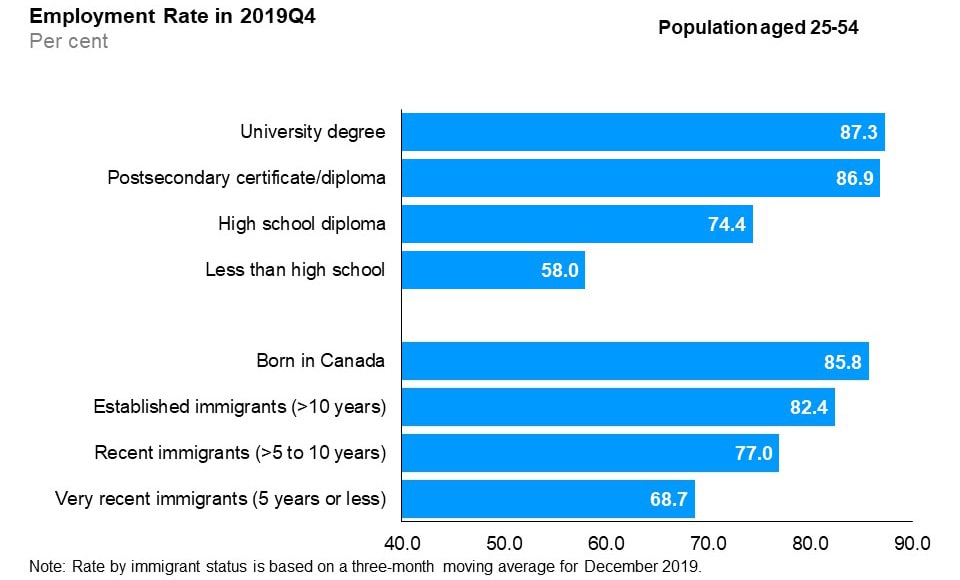
The horizontal bar chart shows employment rates by education level and immigrant status for the core-aged population (25 to 54 years old), in the fourth quarter of 2019. By education level, those with a university degree had the highest employment rate (87.3%), followed by those with a postsecondary certificate/diploma (86.9%), those with a high school diploma (74.4%), and those with less than high school education (58.0%). By immigrant status, those born in Canada had the highest employment rate (85.8%), followed by established immigrants with more than 10 years since landing (82.4%), recent immigrants with more than 5 to 10 years since landing (77.0%), and very recent immigrants with 5 years or less since landing (68.7%).
In the fourth quarter of 2019, those without a high school diploma continued to have the lowest employment rate (58.0%), while university degree holders recorded the highest employment rate (87.3%), followed by postsecondary certificate and diploma holders (86.9%).
Those born in Canada recorded the highest employment rate (85.8%), while very recent immigrants continued to have the lowest employment rate (68.7%).
Unemployment rates by education level and immigrant status (core-aged population)

The horizontal bar chart shows unemployment rates by education level and immigrant status for the core-aged population (25 to 54 years old), in the fourth quarter of 2019. By education level, those with less than high school education had the highest unemployment rate (7.9%), followed by high school graduates (6.0%), those with a postsecondary certificate or diploma (3.6%), and university degree (3.2%). By immigrant status, very recent immigrants with 5 years or less since landing had the highest unemployment rate (8.6%), followed by recent immigrants with more than 5 to 10 years since landing (5.2%), established immigrants with more than 10 years since landing (4.2%) and those born in Canada (3.6%).
In the fourth quarter of 2019, university degree holders recorded the lowest unemployment rate (3.4%) among all education levels. Those without a high school diploma had the highest unemployment rate (7.9%). Year-over-year, the unemployment rate of those with a university degree and those with a postsecondary certificate or diploma decreased, while the unemployment rate for those with and without a high school diploma increased.
Year-over-year, the unemployment rate decreased for all groups by immigrant status, except for those born in Canada (+0.1 percentage points).
Participation rates by education level and immigrant status (core-aged population)
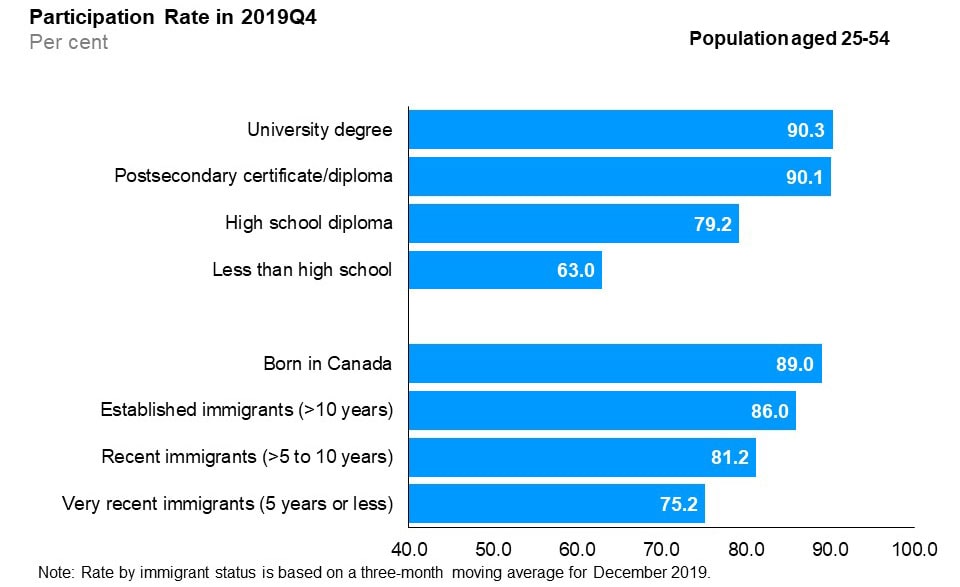
The horizontal bar chart shows labour force participation rates by education level and immigrant status for the core-aged population (25 to 54 years old), in the fourth quarter of 2019. By education level, university degree holders had the highest participation rate (90.3%), followed by postsecondary certificate or diploma holders (90.1%), high school graduates (79.2%), and those with less than high school education (63.0%). By immigrant status, those born in Canada had the highest participation rate (89.0%), followed by established immigrants with more than 10 years since landing (86.0%), recent immigrants with more than 5 to 10 years since landing (81.2%) and very recent immigrants with 5 years or less since landing (75.2%).
In the fourth quarter of 2019, university degree holders continued to record the highest participation rate (90.3%), while those without a high school diploma had the lowest participation rate (63.0%). Year-over-year, the participation rate for university degree holders, those with a postsecondary certificate or diploma and high school diploma holders slightly improved, but slightly decreased for those without a high school diploma.
In the fourth quarter of 2019, recent immigrants and very recent immigrants continued to have the lowest participation rate compared to established immigrants and those born in Canada. Year-over-year, the participation rate for those born in Canada increased (+1.2 percentage points) and decreased for other immigrant groups.
Wages quarterly details
Average hourly wages total, full-time and part-time employees

The line chart shows average hourly wages for all employees, full-time and part-time employees expressed in real 2019 dollars from 1997 to 2019. Real average hourly wages of all employees increased from $25.02 in 1997 to $28.34 in 2019; those of full-time employees increased from $26.86 in 1997 to $30.19 in 2019 and those of part-time employees increased from $16.98 in 1997 to $19.62 in 2019.
The average hourly wage increased in real terms
Hourly wage growth by type of work
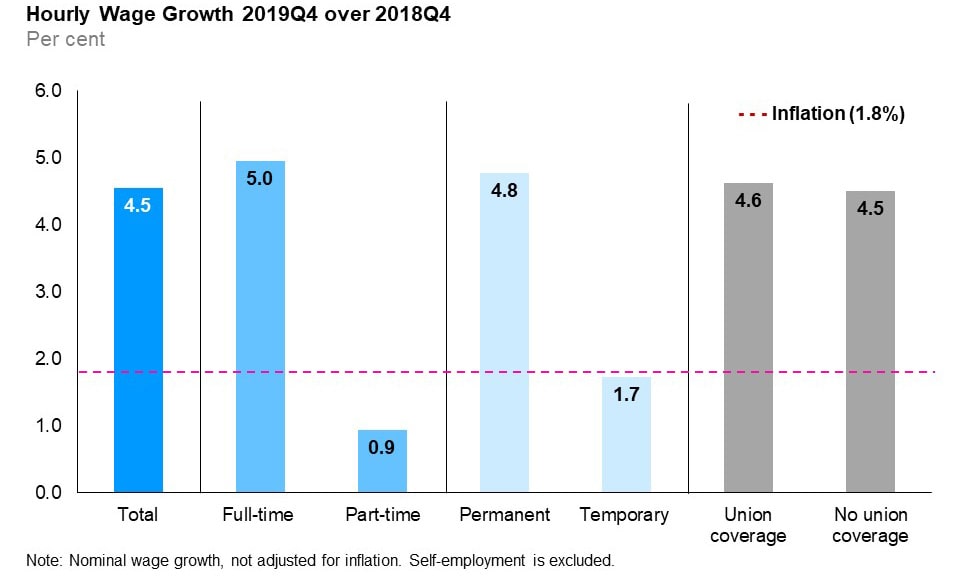
The vertical bar chart shows a year-over-year (between the fourth quarters of 2018 and 2019) nominal per cent change in Ontario’s hourly wages by type of work. The average hourly wage increased by 4.5%. Hourly wages increased for both full-time (+5.0%) and part-time employees (+0.9%); permanent (+4.8%) and temporary employees (+1.7%) and employees with union coverage (+4.6%) and those without union coverage (+4.5%). Inflation during the same period was 1.8%.
In the fourth quarter of 2019, the average hourly wage of Ontario employees was $28.73, an increase of 4.5% from the fourth quarter of 2018.
Average hourly wage rate and wage growth by occupational group
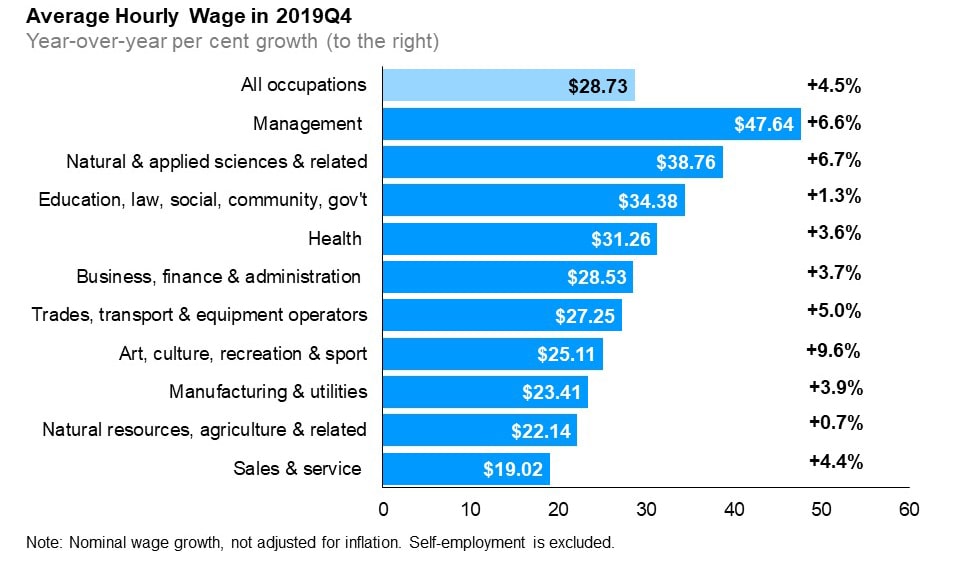
The horizontal bar chart shows a year-over-year (between the fourth quarters of 2018 and 2019) change in Ontario’s average hourly wage rate and growth by occupational group. In the fourth quarter of 2019, the average hourly wage rate for Ontario was $28.73 (+4.5%). The highest average hourly wage rate was for management occupations at $47.64 (+6.6%); followed by natural and applied sciences and related occupations at $38.76 (+6.7%); and occupations in education, law and social, community and government services at $34.38 (+1.3%). The lowest average hourly wage rate was for sales and service occupations at $19.02 (+4.4%).
Year-over-year, all broad occupational groups experienced growth in wages. The three broad occupational groups that experienced the highest wage growth were: art, culture, recreation and sport (+9.6%), natural and applied sciences and related (+6.7%), and management (+6.6%).
Appendix
Overview of annual employment ten-year review
| 2010 | 2011 | 2012 | 2013 | 2014 | 2015 | 2016 | 2017 | 2018 | 2019 | |
|---|---|---|---|---|---|---|---|---|---|---|
| Total Labour Force (000) | 7,160.9 | 7,227.4 | 7,276.4 | 7,383.8 | 7,418.6 | 7,426.1 | 7,489.5 | 7,579.8 | 7,673.0 | 7,890.6 |
| Participation Rate (%) | 66.8 | 66.6 | 66.2 | 66.3 | 65.8 | 65.2 | 65.0 | 64.9 | 64.5 | 65.1 |
| Male Participation Rate (%) | 71.1 | 71.1 | 70.7 | 70.5 | 70.3 | 70 | 69.5 | 69.2 | 68.7 | 69.9 |
| Female Participation Rate (%) | 62.8 | 62.3 | 61.9 | 62.2 | 61.6 | 60.7 | 60.7 | 60.7 | 60.5 | 60.7 |
| Total Employment (000) | 6,537.8 | 6,658.4 | 6,702.6 | 6,823.4 | 6,877.9 | 6,923.2 | 6,999.6 | 7,128.0 | 7,242.4 | 7,452.6 |
| - Full-time (000) | 5,256.1 | 5,373.5 | 5,412.0 | 5,489.5 | 5,540.0 | 5,618.2 | 5,672.6 | 5,778.7 | 5,909.0 | 6,065.8 |
| - Part-time (000) | 1,281.8 | 1,284.8 | 1,290.6 | 1,334.0 | 1,337.9 | 1,305.0 | 1,327.0 | 1,349.3 | 1,333.4 | 1,386.8 |
| Employment-Population Ratio (%) | 61.0 | 61.4 | 60.9 | 61.2 | 61.0 | 60.8 | 60.7 | 61.0 | 60.9 | 61.4 |
| Male Employment (000) | 3,363.6 | 3,450.4 | 3,471.5 | 3,522.8 | 3,567.1 | 3,607.1 | 3,635.9 | 3,700.9 | 3,763.9 | 3,894.7 |
| Female Employment (000) | 3,174.2 | 3,207.9 | 3,231.1 | 3,300.6 | 3,310.8 | 3,316.1 | 3,363.7 | 3,427.1 | 3,478.5 | 3,557.9 |
| Part-Time (% of total) | 19.6 | 19.3 | 19.3 | 19.6 | 19.5 | 18.8 | 19.0 | 18.9 | 18.4 | 18.6 |
| Goods-Producing Sector Employment (000) | 1,380.6 | 1,408.7 | 1,415.3 | 1,397.5 | 1,382.0 | 1,401.4 | 1,418.1 | 1,432.6 | 1,453.1 | 1,467.8 |
| Services-Producing Sector Employment (000) | 5,157.3 | 5,249.7 | 5,287.3 | 5,425.9 | 5,495.9 | 5,521.7 | 5,581.4 | 5,695.4 | 5,789.2 | 5,984.8 |
| Private Sector Employment (000) | 4,268.2 | 4,339.7 | 4,373.0 | 4,447.0 | 4,517.0 | 4,540.7 | 4,597.3 | 4,690.6 | 4,740.6 | 4,863.4 |
| Public Sector Employment (000) | 1,254.7 | 1,294.3 | 1,286.0 | 1,314.0 | 1,305.4 | 1,294.1 | 1,306.4 | 1,329.1 | 1,376.7 | 1,385.9 |
| Self-Employment (% of total) | 15.5 | 15.4 | 15.6 | 15.6 | 15.3 | 15.7 | 15.7 | 15.5 | 15.5 | 16.1 |
| Total Unemployment (000) | 623.1 | 569.1 | 573.8 | 560.3 | 540.7 | 502.9 | 489.9 | 451.8 | 430.7 | 438.0 |
| Unemployment Rate (%) | 8.7 | 7.9 | 7.9 | 7.6 | 7.3 | 6.8 | 6.5 | 6.0 | 5.6 | 5.6 |
| Male Unemployment Rate (%) | 9.4 | 8.2 | 8.3 | 8.0 | 7.5 | 7 | 6.8 | 6.2 | 5.6 | 5.7 |
| Female Unemployment Rate (%) | 8.0 | 7.6 | 7.5 | 7.2 | 7.1 | 6.5 | 6.3 | 5.7 | 5.6 | 5.4 |
| Long-Term (27 wks+) (% of total) | 24.9 | 24.1 | 22.7 | 22.9 | 22.8 | 20.0 | 19.9 | 19.5 | 16.9 | 15.1 |
| Average Unemployment in Weeks | 22.0 | 22.4 | 22.2 | 21.8 | 22.4 | 20.0 | 19.9 | 19.3 | 17.2 | 15.9 |
| Youth Unemployment Rate (%) | 17.4 | 15.9 | 17.0 | 16.2 | 15.7 | 14.7 | 14.0 | 12.3 | 11.9 | 12.1 |
| 25-54 y.o. Unemployment rate (%) | 7.3 | 6.5 | 6.4 | 6.2 | 5.9 | 5.6 | 5.4 | 5.0 | 4.7 | 4.6 |
| 55+ y.o. Unemployment rate (%) | 6.4 | 6.0 | 5.8 | 5.5 | 5.3 | 4.9 | 4.9 | 4.5 | 4.2 | 4.1 |
| Average Weekly Wage Rate ($) | 842.35 | 862.45 | 883.12 | 895.56 | 907.17 | 938.09 | 958.5 | 967.44 | 1,001.74 | 1,036.51 |
| Average Hourly Wage Rate ($) | 23.09 | 23.55 | 24.09 | 24.48 | 24.82 | 25.59 | 26.15 | 26.43 | 27.36 | 28.34 |
Employment by region (000)
| 2010 | 2011 | 2012 | 2013 | 2014 | 2015 | 2016 | 2017 | 2018 | 2019 | |
|---|---|---|---|---|---|---|---|---|---|---|
| Greater Toronto Area | 3,034.6 | 3,077.8 | 3,112.3 | 3,240.2 | 3,241.1 | 3,320.4 | 3,373.2 | 3,442.9 | 3,521.6 | 3,652.9 |
| Central | 1,508.1 | 1,552.0 | 1,551.4 | 1,559.5 | 1,597.2 | 1,597.5 | 1,598.0 | 1,655.2 | 1,656.9 | 1,690.8 |
| Southwestern | 761.7 | 771.1 | 772.9 | 769.4 | 775.0 | 770.5 | 775.8 | 778.4 | 794.3 | 739.5 |
| Eastern | 879.6 | 897.0 | 908.7 | 898.4 | 907.9 | 889.2 | 904.9 | 903.4 | 916.0 | 963.6 |
| Northern | 354.0 | 360.4 | 357.3 | 355.9 | 356.6 | 345.5 | 347.7 | 348.2 | 353.6 | 351.9 |
Unemployment rate by region (%)
| 2010 | 2011 | 2012 | 2013 | 2014 | 2015 | 2016 | 2017 | 2018 | 2019 | |
|---|---|---|---|---|---|---|---|---|---|---|
| Greater Toronto Area | 9.2 | 8.4 | 8.8 | 8.2 | 8.0 | 7.1 | 6.9 | 6.4 | 6.1 | 5.9 |
| Central | 8.4 | 7.4 | 7.0 | 6.9 | 6.2 | 5.9 | 5.9 | 5.3 | 5.2 | 5.1 |
| Southwestern | 9.1 | 8.1 | 7.8 | 7.7 | 7.0 | 6.9 | 6.1 | 5.6 | 5.2 | 5.5 |
| Eastern | 7.2 | 6.7 | 6.6 | 6.6 | 7.0 | 6.7 | 6.4 | 5.7 | 4.9 | 4.9 |
| Northern | 8.3 | 7.8 | 7.2 | 7.4 | 6.6 | 7.2 | 7.1 | 6.4 | 5.8 | 6.0 |
Total employment by CMA (000)
Greater Toronto Area
| 2010 | 2011 | 2012 | 2013 | 2014 | 2015 | 2016 | 2017 | 2018 | 2019 | |
|---|---|---|---|---|---|---|---|---|---|---|
| Toronto | 2,880.3 | 2,923.4 | 2,960.6 | 3,092.1 | 3,087.4 | 3,176.7 | 3,215.0 | 3,289.6 | 3,353.0 | 3,491.5 |
| Oshawa | 184.3 | 189.0 | 190.0 | 194.5 | 201.4 | 196.4 | 214.0 | 210.4 | 220.6 | 218.6 |
Central Ontario
| 2010 | 2011 | 2012 | 2013 | 2014 | 2015 | 2016 | 2017 | 2018 | 2019 | |
|---|---|---|---|---|---|---|---|---|---|---|
| Hamilton | 369.1 | 375.1 | 376.6 | 374.8 | 383.7 | 385.4 | 385.8 | 417.9 | 413.8 | 422.8 |
| Kitchener | 258.1 | 270.5 | 271.6 | 278.9 | 283.1 | 279.8 | 281.6 | 287.8 | 292.2 | 302.1 |
| St. Catharines-Niagara | 190.4 | 196.1 | 201.8 | 193.5 | 195.4 | 204.1 | 203.1 | 197.6 | 201.7 | 199.6 |
| Peterborough | 56.6 | 57.6 | 58.5 | 54.9 | 60.5 | 61.2 | 59.5 | 61.2 | 63.6 | 61.1 |
| Brantford | 67.4 | 68.5 | 67.5 | 68.9 | 68.6 | 69.3 | 70.2 | 72.3 | 70.0 | 78.7 |
| Guelph | 79.2 | 82.0 | 83.9 | 79.8 | 81.8 | 90.5 | 90.6 | 90.8 | 88.8 | 92.6 |
| Barrie | 99.1 | 101.5 | 102.3 | 109.4 | 111.6 | 108.4 | 104.2 | 115.6 | 114.6 | 119.2 |
Eastern Ontario
| 2010 | 2011 | 2012 | 2013 | 2014 | 2015 | 2016 | 2017 | 2018 | 2019 | |
|---|---|---|---|---|---|---|---|---|---|---|
| Ottawa | 515.3 | 517.4 | 535.4 | 523.5 | 533.8 | 531.1 | 543.4 | 546.7 | 557.6 | 590.1 |
| Kingston | 76.7 | 79.3 | 80.6 | 82.6 | 81.4 | 82.9 | 83.6 | 87.3 | 86.4 | 87.5 |
Southwestern Ontario
| 2010 | 2011 | 2012 | 2013 | 2014 | 2015 | 2016 | 2017 | 2018 | 2019 | |
|---|---|---|---|---|---|---|---|---|---|---|
| London | 239.6 | 237.7 | 242.3 | 240.4 | 243.0 | 252.0 | 245.9 | 245.8 | 252.9 | 251.2 |
| Windsor | 147.5 | 147.9 | 153.3 | 154.8 | 155.2 | 158.0 | 164.1 | 162.8 | 164.5 | 170.4 |
Northern Ontario
| 2010 | 2011 | 2012 | 2013 | 2014 | 2015 | 2016 | 2017 | 2018 | 2019 | |
|---|---|---|---|---|---|---|---|---|---|---|
| Sudbury | 80.7 | 82.1 | 80.8 | 83.3 | 83.1 | 82.3 | 81.7 | 81.1 | 81.4 | 85.2 |
| Thunder Bay | 60.2 | 60.3 | 61.8 | 62.8 | 61.5 | 59.7 | 60.1 | 61.5 | 63.7 | 61.7 |
Overview of quarterly employment year-over-year
| 2018q1 | 2019q1 | 2018q2 | 2019q2 | 2018q3 | 2019q3 | 2018q4 | 2019q4 | |
|---|---|---|---|---|---|---|---|---|
| Total Labour Force (000) | 7510.5 | 7728.0 | 7717.1 | 7913.8 | 7782.4 | 8002.8 | 7682.1 | 7917.9 |
| Participation Rate (%) | 63.6 | 64.2 | 65.0 | 65.4 | 65.2 | 65.8 | 64.1 | 64.8 |
| Male Participation Rate (%) | 67.5 | 68.6 | 69.1 | 70.0 | 69.6 | 70.8 | 68.4 | 69.0 |
| Female Participation Rate (%) | 59.8 | 60.0 | 61.1 | 61.0 | 61.1 | 61.0 | 60.0 | 60.7 |
| Total Employment (000) | 7082.3 | 7268.2 | 7269.2 | 7472.1 | 7315.2 | 7535.0 | 7302.7 | 7535.2 |
| - Full-time (000) | 5707.7 | 5858.2 | 5970.2 | 6096.2 | 6049.1 | 6218.9 | 5909.0 | 6089.8 |
| - Part-time (000) | 1374.7 | 1409.9 | 1299.0 | 1375.9 | 1266.0 | 1316.1 | 1393.7 | 1445.4 |
| Employment-Population Ratio (%) | 60.0 | 60.4 | 61.2 | 61.8 | 61.3 | 61.9 | 60.9 | 61.6 |
| Male Employment (000) | 3653.6 | 3771.2 | 3773.8 | 3906.0 | 3833.8 | 3982.6 | 3794.3 | 3919.1 |
| Female Employment (000) | 3428.7 | 3497.0 | 3495.4 | 3566.1 | 3481.3 | 3552.4 | 3508.4 | 3616.1 |
| Part-Time (% of total) | 19.4 | 19.4 | 17.9 | 18.4 | 17.3 | 17.5 | 19.1 | 19.2 |
| Goods-Producing Sector Employment (000) | 1406.8 | 1411.0 | 1451.7 | 1474.0 | 1491.0 | 1512.0 | 1463.0 | 1474.2 |
| Services-Producing Sector Employment (000) | 5675.6 | 5857.2 | 5817.5 | 5998.1 | 5824.2 | 6023.0 | 5839.7 | 6061.0 |
| Private Sector Employment (000) | 4620.0 | 4751.6 | 4756.9 | 4872.6 | 4810.7 | 4944.3 | 4774.8 | 4885.3 |
| Public Sector Employment (000) | 1352.3 | 1368.5 | 1396.0 | 1389.3 | 1373.5 | 1350.5 | 1385.1 | 1435.4 |
| Self-Employment (% of total) | 15.7 | 15.8 | 15.4 | 16.2 | 15.5 | 16.5 | 15.6 | 16.1 |
| Total Unemployment (000) | 428.2 | 459.8 | 447.9 | 441.7 | 467.2 | 467.8 | 379.4 | 382.7 |
| Unemployment Rate (%) | 5.7 | 5.9 | 5.8 | 5.6 | 6.0 | 5.8 | 4.9 | 4.8 |
| Male Unemployment Rate (%) | 6.1 | 6.6 | 5.8 | 5.7 | 5.5 | 5.4 | 5.2 | 5.0 |
| Female Unemployment Rate (%) | 5.2 | 5.3 | 5.8 | 5.5 | 6.6 | 6.3 | 4.6 | 4.6 |
| Long-Term (27 wks+) (% of total) | 16.5 | 16.0 | 17.0 | 14.4 | 16.8 | 13.8 | 17.2 | 16.4 |
| Average Unemployment in Weeks | 17.3 | 16.6 | 17.4 | 15.5 | 13.7 | 13.7 | 17.5 | 16.5 |
| Youth Unemployment Rate (%) | 11.8 | 12.4 | 13.0 | 12.5 | 12.1 | 12.7 | 10.8 | 10.5 |
| 25-54 y.o. Unemployment rate (%) | 4.7 | 5.0 | 4.7 | 4.5 | 5.2 | 4.8 | 4.2 | 4.1 |
| 55+ y.o. Unemployment rate (%) | 5.0 | 4.9 | 4.3 | 4.2 | 4.1 | 4.1 | 3.5 | 3.4 |
| Average Weekly Wage Rate ($) | 994.5 | 1014.3 | 1007.3 | 1035.2 | 1004.2 | 1048.3 | 1000.7 | 1047.6 |
| Average Hourly Wage Rate ($) | 27.3 | 27.9 | 27.4 | 28.3 | 27.3 | 28.5 | 27.5 | 28.7 |
Employment by Region (000)
| 2018q1 | 2019q1 | 2018q2 | 2019q2 | 2018q3 | 2019q3 | 2018q4 | 2019q4 | |
|---|---|---|---|---|---|---|---|---|
| Greater Toronto Area (GTA) | 3466.6 | 3563.5 | 3538.8 | 3659.1 | 3535.7 | 3704.3 | 3545.4 | 3684.9 |
| Central | 1598.5 | 1650.7 | 1646.6 | 1699.4 | 1686.1 | 1698.7 | 1696.3 | 1714.2 |
| Southwestern | 775.2 | 772.4 | 801.3 | 797.0 | 810.3 | 798.0 | 790.3 | 806.7 |
| Eastern | 905.4 | 931.6 | 924.4 | 962.8 | 917.9 | 979.3 | 916.1 | 980.5 |
| Northern | 336.6 | 350.0 | 358.0 | 353.8 | 365.4 | 354.8 | 354.5 | 348.8 |
Unemployment Rate by Region (%)
| 2018q1 | 2019q1 | 2018q2 | 2019q2 | 2018q3 | 2019q3 | 2018q4 | 2019q4 | |
|---|---|---|---|---|---|---|---|---|
| Greater Toronto Area (GTA) | 5.7 | 6.4 | 6.4 | 5.9 | 6.6 | 6.2 | 5.5 | 5.0 |
| Central | 5.8 | 5.2 | 5.5 | 5.1 | 5.6 | 5.5 | 4.1 | 4.7 |
| Southwestern | 5.9 | 6.1 | 5.0 | 4.8 | 5.6 | 6.2 | 4.4 | 4.7 |
| Eastern | 5.0 | 5.2 | 4.8 | 5.2 | 5.1 | 5.0 | 4.6 | 4.2 |
| Northern | 6.6 | 6.1 | 5.9 | 6.8 | 5.6 | 5.7 | 5.5 | 5.2 |
Total Employment by CMA (000)
Greater Toronto Area
| 2018q1 | 2019q1 | 2018q2 | 2019q2 | 2018q3 | 2019q3 | 2018q4 | 2019q4 | |
|---|---|---|---|---|---|---|---|---|
| Toronto | 3305.7 | 3393.6 | 3363.4 | 3492.2 | 3361.9 | 3545.3 | 3380.9 | 3534.9 |
| Oshawa | 211.9 | 222.9 | 228.6 | 227.0 | 222.4 | 214.8 | 219.5 | 209.7 |
Central Ontario
| 2018q1 | 2019q1 | 2018q2 | 2019q2 | 2018q3 | 2019q3 | 2018q4 | 2019q4 | |
|---|---|---|---|---|---|---|---|---|
| Hamilton | 407.7 | 415.1 | 414.3 | 415.4 | 412.4 | 423.1 | 420.7 | 437.6 |
| Kitchener | 276.6 | 295.6 | 286.5 | 306.3 | 303.1 | 303.4 | 302.3 | 303.3 |
| St. Catharines-Niagara | 195.4 | 192.4 | 204.4 | 196.0 | 205.1 | 203.1 | 201.8 | 206.8 |
| Peterborough | 59.5 | 62.2 | 62.0 | 62.3 | 66.3 | 60.7 | 66.5 | 59.2 |
| Brantford | 70.8 | 75.5 | 68.5 | 80.9 | 68.9 | 80.7 | 71.8 | 77.8 |
| Guelph | 87.0 | 94.4 | 86.8 | 95.3 | 88.6 | 91.8 | 92.9 | 89.0 |
| Barrie | 106.3 | 114.9 | 112.3 | 117.9 | 120.9 | 119.2 | 119.1 | 125.0 |
Eastern Ontario
| 2018q1 | 2019q1 | 2018q2 | 2019q2 | 2018q3 | 2019q3 | 2018q4 | 2019q4 | |
|---|---|---|---|---|---|---|---|---|
| Ottawa (Ontario part) | 552.3 | 564.9 | 567.2 | 575.2 | 557.3 | 606.2 | 553.7 | 614.1 |
| Kingston | 85.5 | 86.1 | 87.3 | 91.2 | 87.9 | 87.5 | 85.1 | 85.3 |
Southwestern Ontario
| 2018q1 | 2019q1 | 2018q2 | 2019q2 | 2018q3 | 2019q3 | 2018q4 | 2019q4 | |
|---|---|---|---|---|---|---|---|---|
| London | 245.8 | 246.5 | 257.9 | 244.9 | 260.3 | 251.9 | 247.8 | 261.5 |
| Windsor | 160.9 | 171.5 | 164.2 | 174.4 | 163.7 | 168.6 | 169.1 | 167.2 |
Northern Ontario
| 2018q1 | 2019q1 | 2018q2 | 2019q2 | 2018q3 | 2019q3 | 2018q4 | 2019q4 | |
|---|---|---|---|---|---|---|---|---|
| Sudbury | 78.0 | 84.9 | 80.8 | 85.8 | 82.2 | 85.0 | 84.6 | 85.0 |
| Thunder Bay | 62.2 | 59.8 | 65.7 | 62.3 | 65.3 | 62.6 | 61.7 | 62.3 |
Note: All estimates in this appendix are based on Statistics Canada’s Labour Force Survey.
Footnotes
- footnote[1] Back to paragraph This economic region closely matches the GTA, the main exception being that it excludes the city of Burlington.
- footnote[2] Back to paragraph Real wages are based on nominal wages deflated by the Consumer Price Index (CPI) for all items. Self-employment is excluded.
- footnote[3] Back to paragraph Year-over-year comparison (between fourth quarters of 2018 and 2019) is in nominal dollars.
- footnote[4] Back to paragraph Measured as an increase in the all-items Consumer Price Index for Ontario between October and December of 2018 and October and December of 2019.